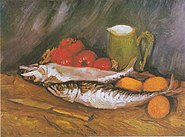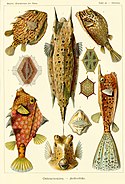The serpent, or snake, is one of the oldest and most widespread mythological symbols. The word is derived from Latin serpens, a crawling animal or snake. Snakes have been associated with some of the oldest rituals known to humankind and represent dual expression of good and evil.

Frogs play a variety of roles in culture, appearing in folklore and fairy tales such as the Brothers Grimm story of The Frog Prince. In ancient Egypt and Mesopotamia, frogs symbolized fertility, while in classical antiquity, the Greeks and Romans associated frogs with fertility, harmony, and licentiousness.

A fish is an aquatic, gill-bearing vertebrate animal with swimming fins and a hard skull, but lacking limbs with digits. Fish can be grouped into the more basal jawless fish and the more common jawed fish, the latter including all living cartilaginous and bony fish, as well as the extinct placoderms and acanthodians. Most fish are cold-blooded, their body temperature varying with the surrounding water, though some large active swimmers like white shark and tuna can hold a higher core temperature. Many fish can communicate acoustically with each other, such as during courtship displays.
The Canary Prince is an Italian fairy tale, the 18th tale in Italian Folktales by Italo Calvino. He took the tale from Turin, making various stylistic changes; he noted it developed a medieval motif, but such tales as Marie de France's Yonec produced a rather different effect, being tales of adultery. A variant on Rapunzel, Aarne–Thompson type 310, The Maiden in the Tower, it includes many motifs that differentiate it from that tale. Other fairy tales of this type include Anthousa, Xanthousa, Chrisomalousa, Petrosinella, Prunella, and Rapunzel.
"The Three Princesses of Whiteland" is a Norwegian fairy tale, collected by Norwegian writers Peter Christen Asbjørnsen and Jørgen Moe in their collection of folktales and legends Norske folkeeventyr (1879). Scottish poet and novelist Andrew Lang collected it his The Red Fairy Book (1890).
"Thirteenth" is an Italian fairy tale originally collected by Sicilian folklorist Giuseppe Pitrè and published by Thomas Frederick Crane in Italian Popular Tales. It is Aarne-Thompson type 328, "The Boy Steals the Giant's Treasures".

"The Old Woman in the Wood" is a German fairy tale collected by the Brothers Grimm, tale number 123. It is Aarne-Thompson type 442.

The Lute Player, The Tsaritsa Harpist or The Tsaritsa who Played the Gusli, is a Russian fairy tale. It was published by Alexander Afanasyev in his collection Russian Fairy Tales, as number 338. Andrew Lang included it in The Violet Fairy Book (1901).

The Mermaid and the Boy is a Sámi fairy tale first collected in the mid-19th century. It tells the story of a prince unknowingly promised to a mermaid before he was born, then obtains magical powers to transform into animals later in the story.

Go I Know Not Whither and Fetch I Know Not What is a Russian fairy tale collected by Alexander Afanasyev in Narodnye russkie skazki.

The Norka is a Russian and Ukrainian fairy tale published by Alexander Afanasyev in his collection of Russian Fairy Tales, numbered 132.

The "Tale of Two Brothers" is an ancient Egyptian story that dates from the reign of Seti II, who ruled from 1200 to 1194 BC during the 19th Dynasty of the New Kingdom. The story is preserved on the Papyrus D'Orbiney, which is currently held in the British Museum.
Biancabella and the Snake is an Italian literary fairy tale written by Giovanni Francesco Straparola in The Facetious Nights of Straparola.

Emelya the Simpleton or At the Pike's Behest is a Russian fairy tale collected by Alexander Afanasyev in Narodnye russkie skazki.

Little Wildrose is a Romanian fairy tale. Andrew Lang included it in The Crimson Fairy Book.

Grateful dead is both a motif and a group of related folktales present in many cultures throughout the world.
"The Three Snake-Leaves" is a German fairy tale collected by the Brothers Grimm, tale number 16. It is Aarne-Thompson type 612, "The Three Snake-Leaves".
The Calumniated Wife is a motif in traditional narratives, numbered K2110.1 in Stith Thompson's Motif-Index of Folk-Literature. It entails a wife being falsely accused of, and often punished for, some crime or sin. This motif is at the centre of a number of traditional plots, being associated with tale-types 705–712 in the Aarne–Thompson–Uther Index of tale-types.
In folkloristics, "The Animal as Bridegroom" refers to a group of folk and fairy tales about a human woman marrying or being betrothed to an animal. The animal is revealed to be a human prince in disguise or under a curse. Most of these tales are grouped in the international system of Aarne-Thompson-Uther Index under type ATU 425, "The Search for the Lost Husband". Some subtypes exist in the international classification as independent stories, but they sometimes don't adhere to a fixed typing.

The Dog in the Sea, also known as The Dog and the Sailor is a northern European fairy tale classified as ATU 540, "The Dog in the Sea".





























